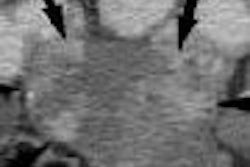MR colonography offers the promise of radiation-free colorectal exams, excellent soft-tissue contrast, and contrast agents with a better safety profile. But a polyp-to-polyp face-off in a phantom study showed that CT colonography (CTC or virtual colonoscopy [VC]) still had a sensitivity edge, especially at normal dose levels.
The team, led by Drs. Johannes Wessling, Roman Fischbach and Alexandra Borchert from the University of Munster in Germany, attributed much of the difference to CT's higher spatial resolution. A total of 25 radiologists with varying experience levels participated in the comparisons.
"The greater potential of contrast resolution with MR imaging theoretically favors MR imaging over CT colonography," the authors wrote. "However, to the best of our knowledge, studies that compare the two techniques in regard to polyp detection are still lacking" (Radiology, August 14, 2006).
The imaging target was a 150-mm long flexible plastic phantom with haustral folds and 10 sessile "polyps" 2-8 mm in diameter. To mimic the effects of adipose tissues in the body, the colon section was encased in lard and submerged in a water-filled body phantom.
Imaging was performed using both four- and 16-detector CT (Volume Zoom and Sensation 16, Siemens Medical Solutions, Malvern, PA), and 1.5- and 3-tesla MRI scanners (Gyroscan models, Philips Medical Systems, Andover, MA). Three-dimensional endoluminal images were assessed by 10 reviewers in each modality, and logistic regression analysis was used to compare sensitivities.
Three different CT protocols were used, including 4 x 10 detector collimation at both normal (100 mAs, 120 kVp) and low-dose settings (10 mAs, 120 kVp, 0.9 and 1.2 mSv for male and female subjects, respectively), and one normal-dose exposure at 16 x 0.75 mm for the 16-slice machine. Section thickness and reconstruction intervals were 1.25 mm and 0.8 mm, respectively.
For the MR experiments, abdominal phased-array coils with equivalent characteristics were not available for both scanners; therefore circularly polarized standard birdcage head coils were used at both 1.5 and 3 tesla to deliver similar spatial homogeneity, the authors wrote.
Imaging was performed with 3D turbo field-echo sequences using the same contrast and geometry parameters for both field strengths: inversion pulse every 99 msec, 3.0/1.44 msec repetition time/echo time, 15 º flip angle, matrix 192 x 123 x 60 over a field-of-view of 350 x 262.5 x 168 mm. The reconstructed voxel size after Fourier interpolation was 256 x 205 x 120 voxels.
The CT and MR image data were sent to a syngo Colonography (Siemens Medical Solutions) workstation, and surface-shaded display was used to create 3D endoluminal views. The images were read by 25 radiologists with two to 16 years of experience, divided into five groups per modality at random, who graded independently for presence, number, and location of lesions, and evaluated the margin definition.
The overall sensitivity for polyp detection at four-detector CT was 87% (95% CI, 80%, 94%) and 92% at 16-detector CT (95% CI, 87%, 97%). Sensitivity at 1.5-telsa MRI was 56% (95% CI: 46%, 66%) and 55% (95% CI, 45%, 65%) at 3.0-tesla imaging.
"The detection of polyps at least 4 mm in diameter was not influenced by the modality or radiation dose (sensitivity 100%)," the authors wrote. "CT performed in low-dose mode depicted all polyps with a diameter of at least 3 mm."
CT was stronger with the smallest polyps. Detection sensitivity for polyps smaller than 3 mm were found with overall sensitivity of just 7.5% at 1.5-tesla MRI, 22.5% at 3.0-tesla MR, 20% at low-dose CT, and a significantly greater (p < 0.001) sensitivity of 67.5% with standard-dose four-detector CT and 82.5% with 16-detector CT.
"Detection rates for MR imaging decreased from 100% to 15% below a threshold diameter of 4 mm, whereas for CT, sensitivity remained high for polyps as small as 3 mm in diameter," the authors wrote. Yet, despite significant differences in sensitivity, both MDCT and MRI readily detected polyps above the clinically significant diameter of 6 mm, they concluded.
As for limitations, the authors noted a lack of routine protocols for 3-tesla MRI. And while radiation dose makes CT less than ideal for screening exams, the long breath-hold required for MR could make routine imaging difficult for that modality. Also, phantoms don't move, so in the clinical setting the resolution benefits of longer imaging times and additional filtering must be balanced against the cost of additional artifacts caused by bowel movement and breathing, the group wrote.
However, the principal disadvantage of MRI in detection came from its poorer spatial resolution vis-a-vis CT. "MR imaging provided interpolated voxels of 1.37 x 1.37 x 1.4-mm edge length; thus the voxel volume is about 4.5 times the volume of 16-section CT and 2.7 times the volume of four-section CT," the group noted.
But on the CT side, the increased imaging noise that accompanies low-dose imaging may have been responsible for a higher rate of false positives, they noted. And there were fewer false positives for four-slice CT.
"Although polyp contour definition for lesions smaller than 6 mm was rated similarly for both CT modalities, we found 16-section CT with the minimum section thickness of 0.75 mm to be most vulnerable to interpretation errors, with an average of 0.9 false-positives results per reader," the team wrote. "However, even though detection rates are comparable, the number of false positives decreased to 50% on four-detector CT. Therefore, in our opinion, a compromise between spatial resolution and image noise is required. Alternatively, smoothing algorithms may be introduced."
By Eric Barnes
AuntMinnie.com staff writer
August 23, 2006
Related Reading
MR colonography shows promise, with drawbacks, in diverticulitis, September 19, 2005
CAD aids polyp detection in 64-slice study, May 12, 2006
VC study finds thin slices more important than low noise, March 27, 2005
New VC reading schemes could solve old problems, October 13, 2005
Copyright © 2006 AuntMinnie.com




















